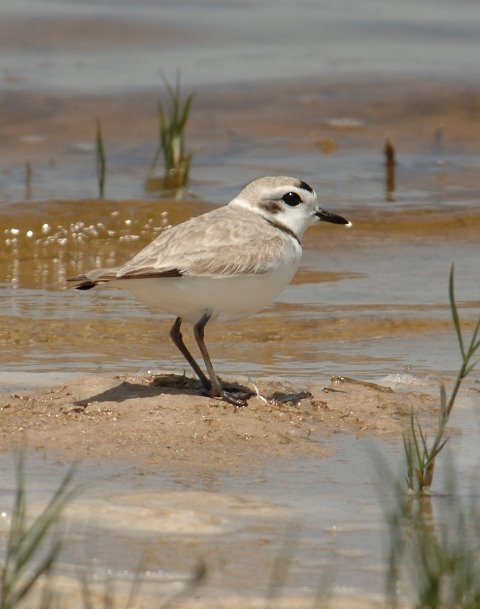.jpg) This week is the annual summer outdoor retail trade show in Salt Lake City. I am speaking (on behalf of National Audubon) this afternoon on a panel discussing birding. What else should we panelists do than go birding before hand? Local Audubon staff arranged for a trip out to the Inland Sea Shorebird Reserve last evening, and we were able to spend a couple of hours touring this fascinating wetland.
This week is the annual summer outdoor retail trade show in Salt Lake City. I am speaking (on behalf of National Audubon) this afternoon on a panel discussing birding. What else should we panelists do than go birding before hand? Local Audubon staff arranged for a trip out to the Inland Sea Shorebird Reserve last evening, and we were able to spend a couple of hours touring this fascinating wetland.The reserve is a constructed wetland, one developed by Kennicott Copper as required mitigation for a mine expansion (see their website for the entire story). According to Kennicott, "KUC actively worked with the Utah Division of Wildlife Resources, the US Fish and Wildlife Services, the Environmental Protection Agency, the Nature Conservancy, the National Audubon Society and the Corps of Engineers on developing the site which was opened in 1997."
We arrived at the wetlands in the late afternoon, long after the grassland birds had quieted for the day. However, on the drive in we did see numbers of typical western scrub and grassland birds such as Sage Thrasher, Lark Sparrow, and Brewer's Sparrow (while exiting we added Northern Harrier and Golden Eagle).
The highlight of our trip was the wetlands that characterize the sanctuary. Snowy Plovers breed prolifically in this area, and among the many that we saw were three downy young. Black-necked Stilt, White-faced Ibis, Canada Goose, and several species of waterfowl (Northern Pintail, Cinnamon Teal, Gadwall) were common in the ponds and pools. Red-winged and Yellow-headed Blackbirds rustled through the reeds. As evening approached several migrant flocks of Franklin's Gulls moved in, stopping before continuing their flights south to their wintering grounds off of the Pacific coast of South America.
I must confess that I am skeptical about the value of many of the mitigation wetlands that I have seen (my preference is to avoid). Yet, in this case, Kennicott and its partners have achieved a success where many have failed. This success has been recognized by Audubon designating the reserve an IBA. I would hope that others involved in mitigation would look to this project as a model of what can be accomplished with thought, planning, sensitivity, and, of course, funding. For more information, read this interesting case study of the reserve by the World Business Council for Sustainable Development.
Particular (and heartfelt) thanks go to the Great Salt Lake Audubon Society chapter for guiding the field trip. I have been associated with Audubon for most of my life, and nothing gives me greater pleasure than meeting a new chapter.
Ted Eubanks
23 July 2009
Video Scan of the Inland Sea Shorebird Reserve
,+Barbuda,+13+Jul++09+(web).jpg)
.jpg)
.jpg) I find these isolated populations of parulids to be among the most fascinating birds. Most of us are exposed to the genus Dendroica through the wood warblers that breed and migrate through the Americas. Many of these birds are long-distance migrants, and only stop briefly in my yard in Galveston to feed and rest before continuing either to the tropics or back to their breeding grounds in the northern forests.
I find these isolated populations of parulids to be among the most fascinating birds. Most of us are exposed to the genus Dendroica through the wood warblers that breed and migrate through the Americas. Many of these birds are long-distance migrants, and only stop briefly in my yard in Galveston to feed and rest before continuing either to the tropics or back to their breeding grounds in the northern forests.
+(web).jpg)








